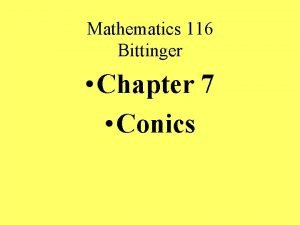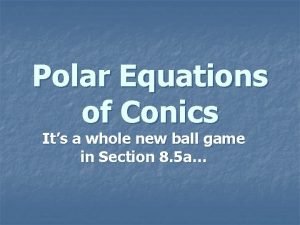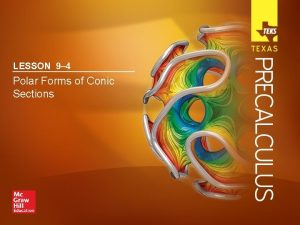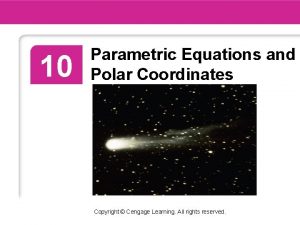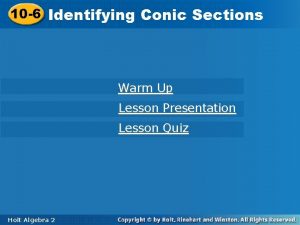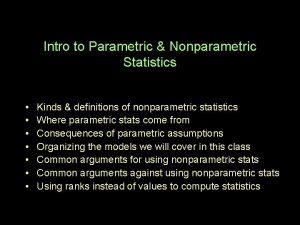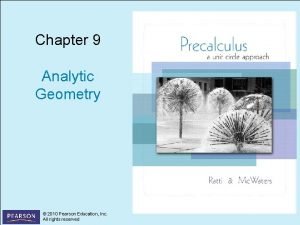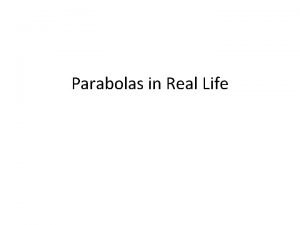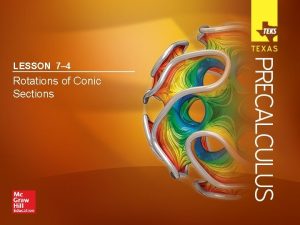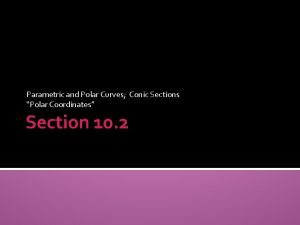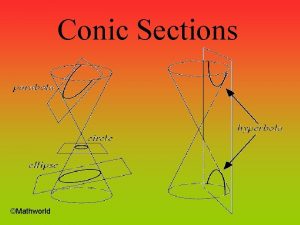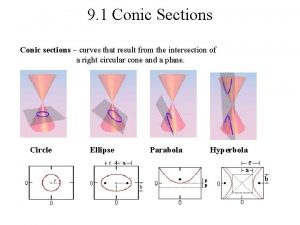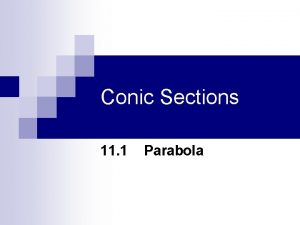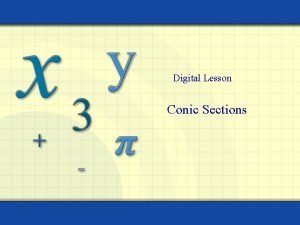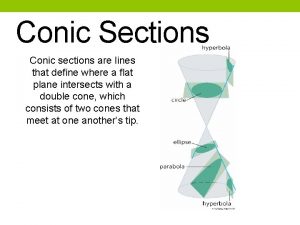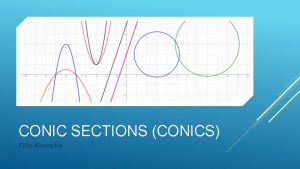Parametric and Polar Curves Conic Sections Parametric Equations




![Example 1 § Sketch the trajectory over the time interval [0, 10] of the Example 1 § Sketch the trajectory over the time interval [0, 10] of the](https://slidetodoc.com/presentation_image_h2/7df25c919d8f895030dc74a127185743/image-5.jpg)












- Slides: 17

Parametric and Polar Curves; Conic Sections “Parametric Equations; Tangent Lines and Arc Length for Parametric Curves” Section 10. 1

All graphics are attributed to: �Calculus, 10/E by Howard Anton, Irl Bivens, and Stephen Davis Copyright © 2009 by John Wiley & Sons, Inc. All rights reserved. ”

Chapter Introduction § In this chapter, we will study alternative ways of expressing curves in the plane. § Curves described in component form (parametric curves) § Polar curves § Conic sections § You have seen all of these in previous years, and we will now find tangent lines, arc length, etc. associated with them.

Parametric Equations § Parametric equations express motion in such a way that the x- and y-coordinates, as functions of time, are: § x = f(t) § y = f(t) § The resulting curve (C) shows the trajectory of the particle described by the equations. § To graph a parametric equation, you may want to start by eliminating the parameter, or by making a table. § NOTE: t = time is the parameter for many, but it can be any independent variable that varies over some interval of real numbers.
![Example 1 Sketch the trajectory over the time interval 0 10 of the Example 1 § Sketch the trajectory over the time interval [0, 10] of the](https://slidetodoc.com/presentation_image_h2/7df25c919d8f895030dc74a127185743/image-5.jpg)
Example 1 § Sketch the trajectory over the time interval [0, 10] of the particle whose parametric equations of motion are: § x = t – 3 sint and § y = 4 – 3 cost. § Solution: Start by making a table and plotting points. § x = 0 – 3*sin(0) = 0 § y = 4 – 3*cos(0) = 1

Example 1 con’t � After completing the table, connect the points with a smooth curve, indicate direction of travel, and label the points with their associated value(s) of t. � There is no t-axis in the picture.

Example 2 �

Orientation �Orientation is the direction in which the graph is traced as the parameter increases. �Indicating this direction of travel on the graph is the difference between a curve and a parametric curve. �The orientation in example 2 was counterclockwise (see the arrow). �To reverse the orientation, we could replace t with –t in example 2. �This does not work for every parametric

NOTE �Not all parametric equations produce curves with definite orientations; if the equations are badly behaved, then the point tracing the curve may leap around sporadically or move back and forth, failing to determine a definite direction. �Example: x = sin t, y = sin 2 t This has an orientation that moves periodically back and forth along the parabola.

Tangent Lines to Parametric Curves �

Example �




Arc Length of Parametric Curves �This arc length formula also comes from the distance formula, as we discussed last week.

The Cycloid (The Apple of Discord) �There is some reading on pages 698 -699 that might interest you regarding application of our work in section 10. 1 that relates to the early study of differentiation and integration during the 1600’s and:

Oh, the memories…
 Chapter 7 conic sections and parametric equations
Chapter 7 conic sections and parametric equations Polar equation of conics
Polar equation of conics Conic sections in polar coordinates
Conic sections in polar coordinates Polar form of conic sections
Polar form of conic sections Conic sections in polar coordinates
Conic sections in polar coordinates Polar curve
Polar curve Parabola cheat sheet
Parabola cheat sheet Conic sections equations
Conic sections equations Bmk+
Bmk+ Parametric test and non parametric test
Parametric test and non parametric test Parametric and non parametric algorithms
Parametric and non parametric algorithms Parametric
Parametric Chapter 9 conic sections and analytic geometry
Chapter 9 conic sections and analytic geometry Chapter 9 conic sections and analytic geometry
Chapter 9 conic sections and analytic geometry Parabola tower
Parabola tower Rotating conic sections
Rotating conic sections Lesson 1 exploring conic sections
Lesson 1 exploring conic sections Conic sections project
Conic sections project
